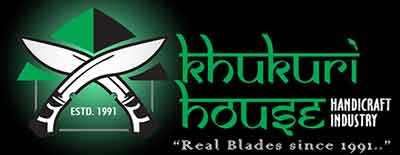Kukri: The Gurkha's national weapon
20th September, 2018
(From Travels in India and Nepal by the Rev Wood, 1896)
The Gurkha is worthy of notice, if only for the remarkable weapon which they use in preference to any other. It is called the "Khukuri" or "Kukri" and is of a very peculiar shape. As may be seen by reference to the drawings both the blade and hilt are curved. The blade is very thick at the back measuring a little more than a quarter of an inch in thickness. From the back it is thinned off gradually to the edge, which has curve of its own, quite different to that of the back, so the blade is widest as well as thickest in the middle, and tapers at one end towards the hilt and the other towards the point. The steel of which the blade is formed is of admirable temper, as is shown by the fact that specimens which had not been cleaned for thirty years, but have been hung upon walls among other weapons, are scarcely touched with rust, and for the greater part of their surface are burnished like mirrors. The point of the Khukuri or Kukri is as sharp as a needle, so that the weapon answers equally for cutting or stabbing. In consequence of the great thickness of the metal, the blade is exceedingly heavy. It may be imagined that a blow from such a weapon as this must be a very terrible one. The very weight of the blade would drive it half through a man’s arm if it were only allowed to fall from a little height. But the Gurkhas have a mode of striking which resembles the "drawing" cut off the broad sword, and which urges the sharp edge through flesh and bone alike.
To make a complete set every Khukuri or Kukri must come with two small knives at the back. The two smaller knives used are of very similar form, but apparently of inferior metal. These are kept in little case attached to the side of the Khukuri or Kukri sheath, just as is the case with the knives attached to a Highlander's dirk.
In the hands of an experienced wielder this Khukuri or Kukri is about as formidable a weapon as can be conceived. Like all really good weapons, Khukuri's or Kukri's efficiency depends much more upon the skill that the strength of the wielder and thus it happens that the little Gurkha a mere boy in point of stature, will cut to pieces of gigantic adversary who does not understand his mode of onset. The Gurkha generally strikes upwards with the Khukuri or Kukri, possibly in order to avoid wounding himself should his blow fail, and possibly because an upward cut is just the one that can be least guarded against.
"When we were engaged in the many wars in India, the Gurkha proved themselves our most formidable enemies, as since they have proved themselves most invaluable allies. Brave as lions, active as monkeys, and fierce as tigers, the lithe wiry little men came leaping over the ground to attack moving so quickly, and keeping so far apart from each other, the musketry was no use against them. When they came near the soldiers, they suddenly crouched to the ground, dive under the bayonets, struck upwards at the men with their Khukuris or Kukris, ripping them open with a single blow, and then, after having done all the mischief in their power, darting off as rapidly as they had come. Until our men learned this mode of attack they were greatly discomfited by their little opponents, who got under their weapons, cutting or slashing with knives as sharp as razors, and often escaping unhurt from the midst of bayonets. They would also dash under the bellies of the officers’ horses, rip them open with one blow of the Khukuris or Kukris, and aim another at the leg of the officer as he and his horse fell together."
Share


